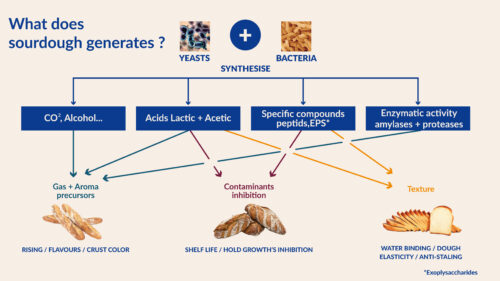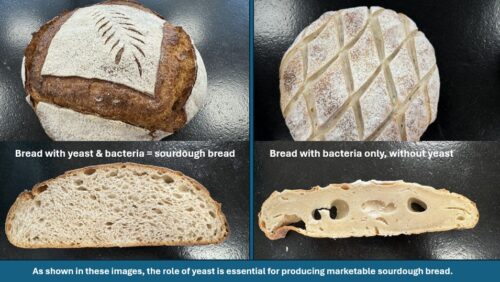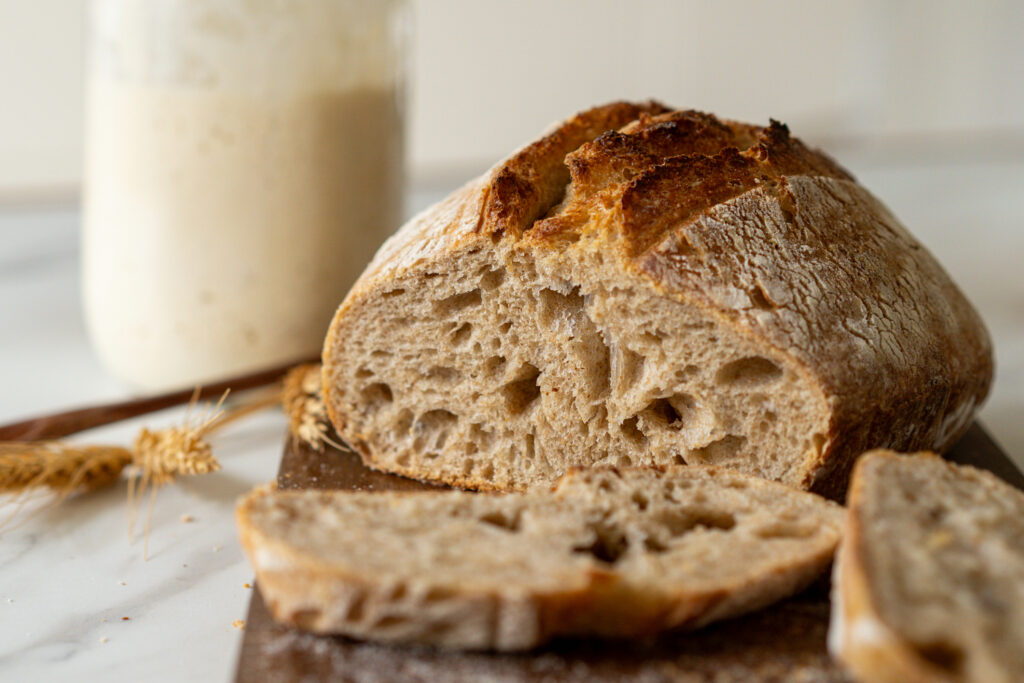The very first ferment used to make bread, sourdough contributes to the positive image of bread products as sources of energy and essential nutrients. Consumers rediscovered sourdough bread in the 1980s and have since embraced its diversity of flavors and textures. Today, sourdough is breaking new ground with new flavors in unexpected applications, such as doughnuts, muffins, croissants, and cookies. On the savory side, sourdough tortillas, pizzas, focaccia, burgers, bagels, and hot dogs are making their way into restaurants. To meet the growing demand for this complex ingredient, a wide range of safe, convenient solutions — leaving plenty of room for creativity — are now available to professionals around the world.
A growing market
According to Market.us, the global sourdough market (including ingredients & products incorporating sourdough in its various forms) is expected to reach approximately $5.7 billion by 2034, up from $2.7 billion in 2024, with a CAGR of 7.7% during the forecast period from 2025 to 2034. Thanks to traditional bread-making practices and a strong preference for artisanal products, Europe still represents the largest market for this ferment, with more than 39.20% market share in 2024. Changing consumer lifestyles and food choices (taste, nutrition, and naturalness) in the Asia-Pacific region are driving growth in this market. In the coming years, experts expect sourdough to breathe new life into the bread industry worldwide.
What is sourdough?
There is no established and internationally recognized legal definition of sourdough bread. Descriptions and regulatory definitions differ from country to country. However, in professional practice, “sourdough is obtained by fermenting a substrate of cereals or pseudo-cereals with lactic acid bacteria (LAB) and yeasts that may be naturally present or added to the fermentation,” explains Héliciane Clement, food science researcher and sourdough expert at Lesaffre.
Sourdoughs can be classified into three main types, depending on their intended purpose:
- A leavening agent containing an active microflora where bacteria and yeasts coexist. Beyond improving flavor and aroma, live sourdough simultaneously ensures dough rising and acidification.
- An acidifier and flavor carrier corresponding to the family of “bacterial” sourdoughs characterized by a strong predominance of lactic acid bacteria, which cause marked acidification of the medium. The addition of baker’s yeast to the mixer is necessary to make the dough rise, as the yeast concentration (less than10⁶CFU) is insufficient.
- An aromatic agent corresponding to the family of sourdoughs that have undergone a drying process and have no fermenting power, also known as devitalized or inactivated sourdoughs.
Today, there are many methods for making sourdough, opening endless doors for professional creativity and culinary applications (breads, pizzas, pastries, brioches, panettone, savory biscuits, and more).
You’ve probably tasted sourdough breads with very different flavors and textures — and that’s perfectly normal. There isn’t just one kind of sourdough, but a vast variety influenced by numerous parameters.
- Firstly, the raw materials used to make it. “In France, for bread to be classified as ‘sourdough bread’, regulations specify that it must be made from rye or wheat flour. But in other countries, rice, cassava, chickpea flour, etc. can be used,” says Héliciane Clement.
- The way the sourdough is inoculated also affects the final product. Inoculation can be spontaneous, by mixing water and flour and refreshing regularly so that a consortium of microorganisms forms naturally. It can also be done using a sourdough starter, with microorganisms selected to obtain an active sourdough that is ready to use.
- Finally, the processes involved in maintaining sourdough include many parameters that can modify it infinitely: temperature, hydration, quantity of inoculum, etc.
No sourdough without yeast
Contrary to popular belief, there is no leavened bread without yeast. Traditional sourdough naturally contains yeast, and the most commonly found species is Saccharomyces cerevisiae, the famous baker’s yeast, of which there are many wild strains. It should be noted that more than 40 species of yeast of different genera (Kazachstania, Candida, Pichia, etc.) have already been described in the sourdough ecosystem(1). Although the main contribution of sourdough yeast is to leaven the dough, and therefore the texture of the crumb, it also plays an important role in the formation of bread aromas, made possible by slow fermentation.
The second essential ferment in sourdough is lactic acid bacteria, with certain species frequently found, such as Lactiplantibacillus plantarum, Levilactobacillus brevis, and Fructilactobacillus sanfranciscensis, but more than 110 species of bacteria have been identified in sourdough starters.
During fermentation, lactic acid bacteria produce lactic acid and acetic acid, which generate acidity and lower the pH of the dough. Now you understand why some sourdough breads have a characteristic acidity. This lactic fermentation specific to these bacteria also has the advantage of inhibiting the activity of fungal microorganisms that can cause bread to mold and slow down its staling. Many sourdough breads can therefore be consumed over several days, which is an advantage in terms of reducing food waste.

For sourdough manufacturers, knowledge of sourdough microbiology is essential for creating combinations of yeast and bacteria strains that will shape the sensory profile of their products. For example, the microbial flora of a sourdough specific to rye bread will bring tart, fruity, and acetic notes, while that of a sourdough for panettone will bring creamy notes typical of butter and lactic acidity. The art lies in properly guiding and controlling the living ecosystem of sourdough, often the result of several years of experience.
Yeasts and bacteria are inseparable in sourdough
We now know that these two ferments act in a complementary manner in the bread microbiota and together contribute to the texture and taste of bread. Proof of this synergy is that the amino acids released by the action of lactic acid bacteria peptidases are used by yeasts to produce aromatic compounds.
These two microorganisms are also inseparable because lactic acid bacteria alone produce too little CO₂ to make the dough rise. With CO₂ production three to four times higher than that of lactic acid bacteria, the presence of yeast is essential to obtain a satisfactory volume.
In practice, many bakers add a small amount of baker’s yeast (Saccharomyces cerevisiae) during the final kneading stage to boost the rise of doughs that lack vigor. French regulations on sourdough production, which are among the strictest in the world, allow a maximum dose of 0.2% of the weight of the flour. This practice is particularly beneficial for acidic dough (pH<4.5), where the concentration of organic acids hinders the fermentation activity of the yeast.

How are professionals developing the range of “sourdough” bread products?
Nowadays, the vast majority of bakers and manufacturers buy starters (bread starters combining selected pure strains of active yeast and bacteria) and ready-to-use active sourdough starters (liquid or paste). This is a great opportunity for the democratization of sourdough, but also for consumers, who are discovering an increasingly wide variety of sourdough-based baked goods, such as sandwiches, brioches, specialty breads, rolls, crumpets, Swedish crackers, sandwich bread, pizzas, and more.
“Thanks to the carefully studied combination of yeast strains and lactic acid bacteria from sourdough, starters allow each baker to create their own sourdough, using traditional methods, in a single fermentation step. Each starter brings a specific aromatic profile to the bread made, depending on the flour used, the fermentation process used, and the baking diagram applied, giving the finished product typical “sourdough” notes: more or less acetic, more lactic, fruity, spicy, etc.,” explains Madeleine Nlandu Mputu, Baking Project Management Officer at Lesaffre.
At the same time, ready-to-use live sourdough starters combine all the advantages of sourdough made by the baker without any of the disadvantages. Made like traditional sourdough from selected flours (wheat, rye, buckwheat, einkorn wheat, etc.), water, yeast, and lactic acid bacteria, they are appreciated by professionals, whether beginners or experienced. Indeed, thanks to their mastery of recipes and processes, bakers can put their own signature on their breads and brioches.
And did you know that sourdough can be a lever for developing less fatty sweets?
“At the Lesaffre Baking Center™, we have shown that our live durum wheat sourdough (LVBD 3000), used at between 5 and 15% of the flour weight, adds buttery and milky notes to the finished product, allowing the butter content to be reduced by 10 to 20% depending on the type of brioche recipe used, without impacting its taste or smell,” explains Madeleine Nlandu Mputu.
All the aromas of sourdough concentrated…
The growth in the range of products with the distinctive characteristics of sourdough is also being boosted by the development of devitalized sourdough in powder, liquid, or paste form. Easy to use (measured out for the powder version at between 1 and 4-5% of the weight of the flour), they can be used to make more than a dozen different types of bread from a single dough recipe. “With their incomparable aromas, these devitalized sourdoughs are made by drying traditional sourdoughs,” explains Madeleine Nlandu Mputu. Professional bakers, pastry chefs, and biscuit makers can choose their product based on the flour base (wheat, rye, wheat germ, barley, buckwheat, spelt, etc.), color (from white to dark brown), acidity level, and desired flavor profile.
Ultra-practical and economical preparations are also being developed. One of these will be particularly popular with the arrival of the ever-popular panettone this winter.
“Based on an all-in-one preparation, we have developed a blend using sourdough without monoglycerides or DATEM, which allows us to make panettone with an authentic taste and texture in 5 to 6 hours instead of the usual 48 to 72 hours,” explains Madeleine Nlandu Mputu.

Thanks to its versatility, sourdough can be adapted to milder, creamier flavor profiles, which are now finding niche markets in the production of hamburger buns, pancakes, waffles, and doughnuts. And consumers are not to be outdone, trying out original recipes such as sourdough chocolate chip cookies, which are creating a buzz on social media.
What are the drivers of innovation in sourdough and fermented flours today?
Research into sourdough, its flora, and its functionalities is particularly active. Several major trends are emerging in terms of patents and scientific publications:
- Understanding the microbial ecosystem to better control it
The Metapath project, in which Lesaffre is involved, aims to study the dynamics of the microbial consortium in sourdough in greater depth in order to better understand them.
“The complex and highly variable composition of flour constantly changes once mixed with water, due to the wide variety of enzymes and microorganisms present, which interact constantly with each other and are sensitive to environmental factors. All these factors make sourdough a powerful and robust tool, but one that is difficult to control. The Metapath project aims to assess the impact of each parameter (raw materials, microorganisms, process) on sourdough fermentation: why sourdough sometimes acidifies more, or less, why it changes smell,” explains Héliciane Clement.
Launched in 2021, the Metapath project is due to be completed by the end of 2025.
Multi-omic approaches enable comprehensive profiling of the microbial community composition, gene expression profiles, metabolic activities, and functional outcomes during fermentation.
In the future, customized starters could be developed with desired characteristics, such as dough rising, acid tolerance, and the production of specific volatile compounds.
- Optimizing the antifungal capabilities of sourdough starters
According to Oleinikova et al (2025), sourdough is one of the best alternatives to chemical preservatives(2). By exploring the microbial biodiversity of sourdough, research is being conducted to select the most effective bacteria that produce antimicrobial substances, extending the shelf life of bread. Similarly, co-fermentations of lactic acid and propionic acid bacteria are being examined with the aim of offering natural alternatives to calcium propionate(3),a preservative commonly used in packaged baked goods.
- As part of a CSR approach, responsible sourdough is also being developed with tailor-made solutions to transform bread waste into sourdough for professionals. Approximately 10% of the bread produced worldwide is wasted during the supply chain, from the manufacturer to the end consumer. Due to its high carbohydrate content, bread waste, once hydrolyzed by microbial enzymes, is considered an excellent raw material for fermentation and sourdough production(4).
- Exploring the functional potential of sourdough made with unconventional ingredients such as cereals (rice, oats, sorghum, barley, millet, teff, Tritordeum, etc.), pseudo-cereals (buckwheat, amaranth, quinoa, etc.), legume flours (chickpea, peas, etc.) and cereal by-products(5).The focus is on the role of fermentation in enhancing the nutritional, functional, and technological properties of these alternatives or supplements to wheat and rye.
- Improving the organoleptic qualities of gluten-free or low-gluten breads using selected sourdough starters
Beyond the sensory aspect, the incorporation of sourdough is a promising approach to improving the technological and nutritional quality of gluten-free or low-gluten breads, which are generally intended for people with non-celiac gluten intolerance and irritable bowel syndrome (IBS)(6).
In a context of dietary transition and the promotion of cereal production chains, sourdough is a ferment with a promising future: it can improve the organoleptic quality and shelf life of products, reduce the use of additives, and contribute to a more responsible diet. A detailed understanding of its microbial communities, their interactions, and their metabolic functions paves the way for major technological advances in the bread-making of tomorrow.
By combining science and expertise, it reconciles technological performance, authenticity, and sustainability—values that are at the heart of today’s global baking industry.
Sourdough bread: health benefits?
There is a wealth of scientific literature on the potential nutritional benefits of sourdough. However, the variability of flours, recipes, strains, quantities of ferments, and manufacturing processes is such that it is currently impossible to reach a clear scientific consensus on any potential benefits. This is why health authorities such as the EFSA and the FDA have not yet approved any claims regarding the health benefits of sourdough. It is worth referring to recent scientific publications by Ribet(7) & al. (2023) and Amico(8) & al. (2023) to understand that many of the health benefits touted in magazines, on social media, and by certain bakers are not relevant. For baking professionals, it is now counterproductive to pit yeast against sourdough in terms of health. As already mentioned on this blog, bread made from cereal flour, water, and salt, whether sourdough or yeast-based, is a food that promotes nutrition and health as long as it is consumed in moderation, like any other food. Today, good “bread” that meets consumer expectations in terms of taste, texture, and nutritional value is based on a complex equation involving the choice of ingredients, ferments, and manufacturing processes, which are at the heart of the research conducted by the team at the Lesaffre Institute of Science & Technology’s Center of Excellence for Breadmaking Research & Innovation.
Sources :
- Calvert MD, Madden AA, Nichols LM, Haddad NM, Lahne J, Dunn RR, McKenney EA. A review of sourdough starters: ecology, practices, and sensory quality with applications for baking and recommendations for future research. PeerJ. 2021 May 10;9:e11389. doi: 10.7717/peerj.11389.
- Oleinikova Y, Amangeldi A, Zhaksylyk A, Saubenova M, Sadanov A. Sourdough Microbiota for Improving Bread Preservation and Safety: Main Directions and New Strategies. Foods. 2025 Jul 11;14(14):2443. doi: 10.3390/foods14142443. PMID: 40724264; PMCID: PMC12542873.
- Yujuan Yu, Jiale Wang, Faizan Ahmed Sadiq, Honghong Cheng, Aowen Liu, Yan Liu, Senmiao Tian, Jingjing Liang, Ling Zhu, Guohua Zhang, Enhancing sourdough fermentation with AI and multi-omics: From natural diversity to synthetic microbial community,Trends in Food Science & Technology, Volume 165, 2025, 105233, ISSN 0924-2244, https://doi.org/10.1016/j.tifs.2025.105233.
- Fois, S.; Tolu, V.; Sanna, V.; Loddo, A.; Sanna, M.; Piu, P.P.; Piras, D.; Roggio, T.;
- Catzeddu, P. Valorizing Carasau Bread Residue Through Sourdough Fermentation: From Bread Waste to Bread Taste. Microorganisms 2025, 13, 1745. https://doi.org/10.3390/microorganisms13081745
- Islam, M.A.; Islam, S. Sourdough Bread Quality: Facts and Factors. Foods 2024, 13, 2132. https://doi.org/10.3390/foods13132132
- Hernández-Figueroa, RH ; López-Malo, A. ; Mani-López, E. Fermentation du levain et réduction du gluten : une approche biotechnologique pour les troubles liés au gluten. Microbiol. Res. 2025 , 16 , 161. https://doi.org/10.3390/microbiolres16070161
- Ribet L, Dessalles R, Lesens C, Brusselaers N, Durand-Dubief M. Nutritional benefits of sourdoughs: a systematic Review. Adv Nutr. (2023) 14:22–9. doi: 10.1016/J.Advnut.2022.10.003 - DOI - PMC - PubMed
- D’Amico V, Gänzle M, Call L, Zwirzitz B, Grausgruber H, D’Amico S, Brouns F. Does sourdough bread provide clinically relevant health benefits? Front Nutr. 2023 Jul 20;10:1230043. doi: 10.3389/fnut.2023.1230043. PMID: 37545587; PMCID: PMC10399781.


